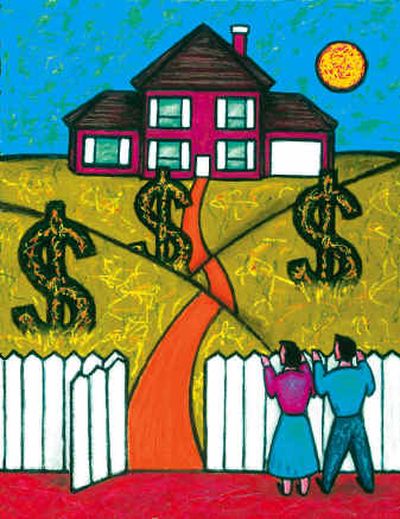Sifting Cash out of your House

Forward or reverse?
If you are retired and strapped for cash, you should seriously consider a reverse mortgage, which will allow you to tap into your home’s value without making any repayments during your lifetime. Yet many retirees balk at this advice because of the hefty fees involved.
How about a conventional (or “forward”) mortgage instead? Thanks to the lower costs, it’s an intriguing idea. But it’s hard to make the strategy work.
To understand why, suppose you are age 75 and single, and you own a $250,000 house. You are trying to choose between a reverse and a conventional mortgage.
According to the reverse-mortgage calculator at www.reversemortgage.org, you might be able to borrow as much as $169,750 with a home-equity conversion mortgage. After deducting $18,716 in closing costs and fees, you would be left with $151,034. You could take this as a lump sum, a credit line or a $1,026 monthly check.
In each case, the money would be tax free. The sum borrowed, plus accumulated interest, wouldn’t have to be repaid until you move or die.
Meanwhile, even if you want a conventional mortgage, you may not find a lender. “A lot of people who take out reverse mortgages can’t qualify for a forward mortgage,” says Ken Scholen, head of AARP Foundation’s reverse-mortgage education project. “They just don’t have the income.”
But assuming you qualify, conventional mortgages offer two key advantages. First, the upfront costs are far lower. You can close on a regular mortgage for less than $3,000 and establish a home-equity line of credit for next to nothing.
Second, the interest charged is typically tax-deductible. With a reverse mortgage, the interest cannot be deducted until the loan is paid off, usually after the homeowner dies. At that point, the deduction may be of little or no value.
But a conventional mortgage also comes with one huge disadvantage: You have to make monthly loan payments. Let’s say you took out a 30-year fixed-rate mortgage for $200,000, equal to 80 percent of your home’s $250,000 value. Knock off $3,000 in closing costs, and that leaves $197,000.
If you then invested this $197,000 in corporate bonds yielding 5.5 percent, you would collect monthly interest of $903. But your monthly mortgage payment would be $1,238, based on today’s 6.3 percent mortgage rate.
To be sure, you could both cover the mortgage and also generate spending money by eating through the $197,000. But that’s dangerous; eventually you will run out of money.
Before you ditch the idea of a conventional mortgage, however, consider two other strategies.
First, if you need to borrow a modest sum for a few years, you might start with a line of credit that allows you to tap into your home equity. If you later have problems servicing the loan or you need to borrow more, you could go for a longer-term solution, like trading down to a smaller home or replacing the credit line with a reverse mortgage.
Or, suppose you took out a 6.3 percent mortgage for 80 percent of your home’s $250,000 value. But this time you use the proceeds to buy an immediate-fixed annuity that pays lifetime income. According to www.webannuities.com, the annuity might kick off $1,643 a month if you are a 75-year-old woman and $1,809 if you are a man, easily covering the $1,238 mortgage payment. At least a portion of each annuity check would be taxable.
Thanks to this financial finagling, you would boost your monthly income by $405 if you are a woman and $571 if you are a man. True, that’s less than the $1,026 you got with the reverse mortgage. But with the conventional mortgage, there’s a payback: Over time, your debt will shrink, not grow. In fact, the longer you live, the more attractive the strategy becomes.